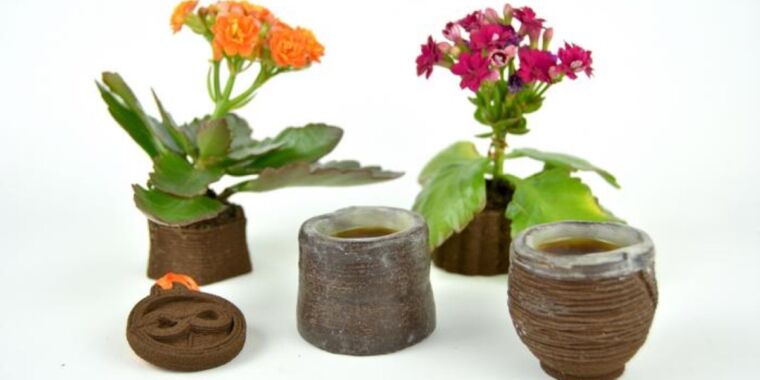- cross-posted to:
- 3dprinting
- cross-posted to:
- 3dprinting
The dried grounds were sifted with a standard kitchen strainer to remove large clumps and then mixed with xanthan gum and carboxymethyl cellulose powders, which serve a similar purpose to binders, stabilizers, and thickeners.
Yeah, so don’t throw out those used coffee grounds, just mix them with the carboxymethyl cellulose powder you probably have in the cupboard, and the leftover xantham gum you have laying around.
Then make a custom syringe feeder for your 3d printer.
Both of those ingredients are cheap, and Xantham Gum in particular is used in gluten free baking recipes a lot.
its a thickener in sauces too, very handy and all natural despite the scary name
it can also be used to make frappucinnos, since you’re already making coffee.
It being natural doesn’t mean anything, though. Plenty of naturally dangerous things out there…
this is not one of them. Xanthan gum is a food additive created by a sugar that’s fermented by a bacteria. It’s a soluble fiber and commonly used to thicken or stabilize foods.
I don’t doubt it, I just have a problem with the reasoning that something is “natural” and therefore good. It’s a common misconception that charlatans use to prey on people.
the inverse is true as well so its kinda moot
Too bad only about 1% of populace has celiac spruce.
And your things still look like they were printed with solidified shit.
Meh. Easier to put them on my grass and fertilize the soil.
I use coffee grounds for D&D terrain. They simulate dirt nicely by themselves, but with a wash and some flocking they look great.
This is the best summary I could come up with:
But if you’re looking for a truly novel application for coffee grounds, consider using them as a sustainable material for 3D printing, as suggested by a recent paper published in DIS '23: Proceedings of the 2023 ACM Designing Interactive Systems Conference.
“You can make a lot of things with coffee grounds,” said co-author Michael Rivera of the University of Colorado, Boulder, and the ATLAS Institute, who specializes in digital fabrication and human-computer interactions.
As 3D printers have moved into more widespread use, it has sparked concerns about environmental sustainability, from the high energy consumption to the thermoplastics used as a printing material—most commonly polylactic acid (PLA).
Adding biomass fillers (bamboo or hemp fiber, oyster shells, and yes, spent coffee grounds) makes recycling even more labor and energy intensive.
Inspiration struck while Rivera was a graduate student at Carnegie Mellon University and a regular at Arriviste Coffee Roasters cafe in Pittsburgh.
The dried grounds were sifted with a standard kitchen strainer to remove large clumps and then mixed with xanthan gum and carboxymethyl cellulose powders, which serve a similar purpose to binders, stabilizers, and thickeners.
The original article contains 882 words, the summary contains 184 words. Saved 79%. I’m a bot and I’m open source!
Many of these types of ideas are to use an easily compostable material and mix it into the plastics as a filler or add tons of binders. The most common 3d printing plastic PLA, is technically biodegradable but will only undergo sufficiently rapid degradation in industrial composters which have elevated temperatures. I was investigating using cellulose acetate based filament but it seems there are still quite a few issues with what I was able to find in the literature (low flexibility and brittle, additives can interfere with biodegradability). Some proposed methods use other plastics that seem to respond well when mixed with cellulose and the same plasticizers but I haven’t seen much other literature focusing on making cellulose based (as the main polymer, not as an additive) filament (not printed dissolved in a solvent as a gel and then dried).
https://www.youtube.com/watch?v=jCsnVp6mEbk
As for this method, if using binders that are easily and cheaply made, and are biodegradable, then I see no issue other than needing to use specialized printers. TBH I wouldn’t mind prints which can’t withstand being dipped in water because most prints probably aren’t being wetted anyways.
I don’t drink coffee but I dispose of tea leaves in the pots of my house plants. Seems a bit simpler, not gonna lie.
Wait, what? I need more information. You probably mean loose leaf but I guess you could just cut open a used bag? But surely that’s like, one bag a month or something. I drink like 6 cups of tea a day, how long does it take before you can add more? (I had this problem with composting when I learned I could add like a small peel per week and I was like… I generate 10x that per day.)
I do loose leaf yeah but I don’t see why you couldn’t cut open teabags. And my tea consumption is a lot less than yours. But give it a try. If the pot fills up you’ll just have to go to plan B. I don’t pay that much attention to the decomposition rate but it’s probably fairly slow.
Just a heads up: not all plants like this because the tannic acid can make the soil too acidic for them.







